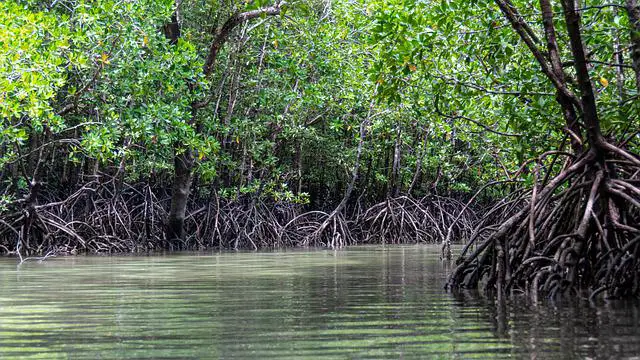Ecosystem
Ecosystem are defined as dynamic complex of plants, animal and micro-organism communities and their non-living environment interacting as a functional unit. Ecosystems contain biotic or living elements as well as abiotic factors or nonliving elements. Biotic factors include plants, animals, and various other organisms. Abiotic factors include temperature, humidity and rocks. Each factor in an ecosystem depends on every other factor, either directly or indirectly. If any one part in the system is damaged, it can have an impact on the whole system. Humans are also integral part of the ecosystem. Ecosystems can be terrestrial, marine, inland or coastal, rural or urban.

Ecosystems can widely vary in size – they can be very large or very small. One such example of tiny ecosystems are the ponds left by the ocean as tide goes out. They are dependent on the changing level of ocean water. Some organisms such as seaweed flourish in an aquatic environment, when the tide is in and the pool is full. Seaweed, which is a kind of algae uses photosynthesis to create food and herbivores such as abalone eat these seaweeds. Other organisms such as hermit crabs, depend on the shallow pools left by low tides as they cannot live underwater. In this way, the biotic parts of the ecosystem depend on abiotic factors for existence.
The whole surface of our planet is a series of connected ecosystems. Ecosystems are often connected in a larger biome which are larger sections of land, sea or atmosphere. For example, forests, ponds, tundra and reefs are all types of biomes. Within each forest, each pond, each tundra or each part of reef, various ecosystems are present which are organized generally based on the types of plants and animals that live in them.
Also Read: Ecosystem Valuation & Services | Meaning, History & Example
Human Well Being
Human well-being is a multi-dimensional concept, with various interpretations and no universally accepted definition, which in part explains the challenges in linking it to ecosystem services. Human well-being refers to positive physical, social and mental conditions and not just the absence of negative situation such as disease. Human well-being includes both objective dimensions such as level of wealth (economic) and air quality (environmental), and subjective dimensions such as self-reported life satisfaction.
Although human well-being can be described, it lacks a universally acceptable definition and has various interpretations. Human well-being cannot be directly observed and it cannot be independently measured so there are many terms that are often used interchangeably with human well-being – welfare, quality of life, development, living standards, utility and so on. Generally, human well-being includes basic material needs for a good life, experience of freedom, health, personal security and good social relations. However, well-being is experiential, what people value being and doing varies. The determinants of the same are sometimes expressed as commodity inputs, many of which are provided by ecosystem services. They include food, fuel, fiber, forest products, clean water, marketed crops, livestock and minerals.
Related: The Nature of Human Well-being
Ecosystem Services
The ecosystem services approach refers to the interdependencies between nature and human well-being. The interaction between plants and animals that makeup biodiversity provides us with a range of services. The range of benefits that we derive from the ecological infrastructure is ecosystem services. Ecosystem services are the benefits people obtain from ecosystems: provisioning services (also known as goods) such as food and water; regulating services such as food, pest, and disease control; cultural services such as recreational and spiritual benefits; and supporting services, such as nutrient cycling, that maintain the conditions for life on Earth. Ecosystems are essential for human well-being through their provisioning, regulating, cultural and supporting services. Human well-being can be enhanced through sustainable human interaction with ecosystems with the support of appropriate instruments, technology, institutions and organizations.
Ecosystem service values offered by Mangroves
Mangroves have huge ecological significance, both to the functioning of the natural environment and to the human beings. Mangroves provide a number of valuable ecosystem services that contribute to human well-being, including provisioning (fuel wood, timber), regulating (storm, flood and erosion control), cultural (recreation, aesthetic) and habitat services (breeding, spawning).
As a coastal species, they act as both barriers preventing soil erosion and protecting inhabitants from storms and biofilters for nutrients in upland runoff, such as nitrogen and phosphorus. Moreover, they form the basis of a detrital food chain, where the fallen leaves provide coastal waters with much of their productivity and this high level of productivity contributes to the wide array of species that inhabit mangroves or use them as refuges or migration sites.
Mangroves support enormous biodiversity as they provide habitat for aquatic and terrestrial fauna and flora. Many threatened and endangered species inhabit mangrove forests such as the Royal Bengal tigers, manatees; hundreds of bird species have been identified in the forests and numerous species of tropical and sub-tropical marine species such as fish and crustaceans spend some part of their lives in mangroves. These forests are also home to various insects, snakes and lizards which are actually the most abundant above the tide.
It has now been recognized that the mangroves are incredible carbon sinks, sequestering more carbon than any of their terrestrial counterparts. Mangrove forests sequester approximately 1.5 metric tons/hectare/yr of carbon. Mangrove substrate may contain 20-25% carbon, which may also help explain the high productivity and biodiversity of these ecosystems.
Also Read: